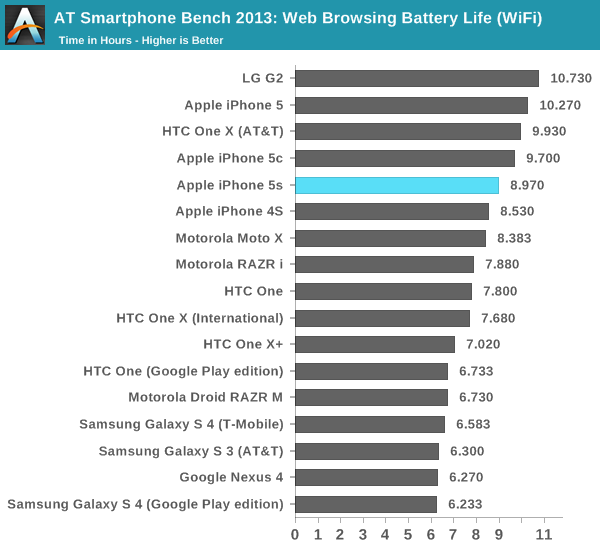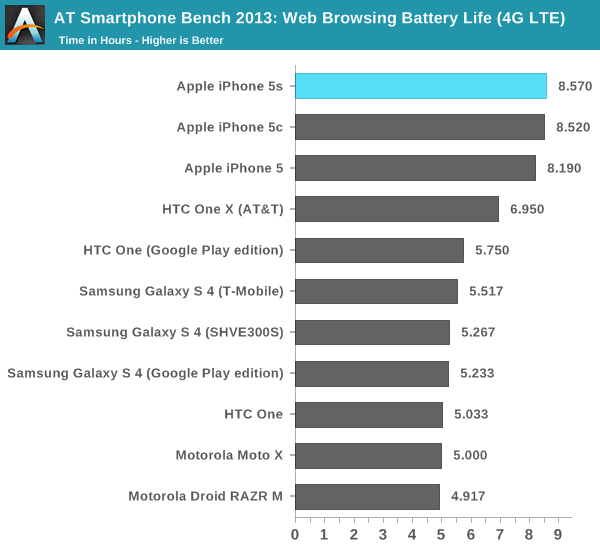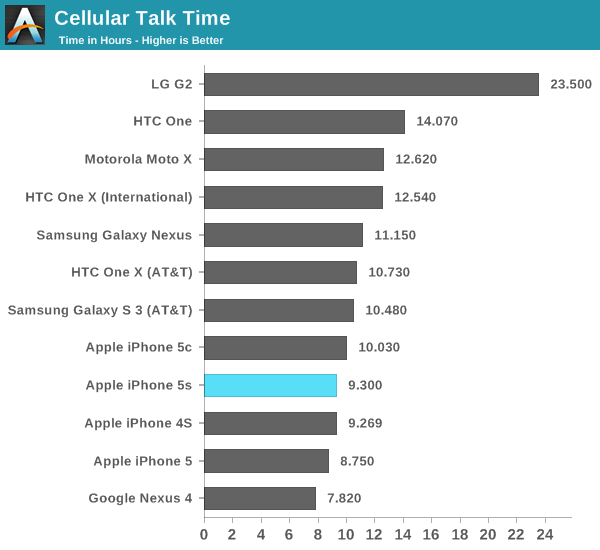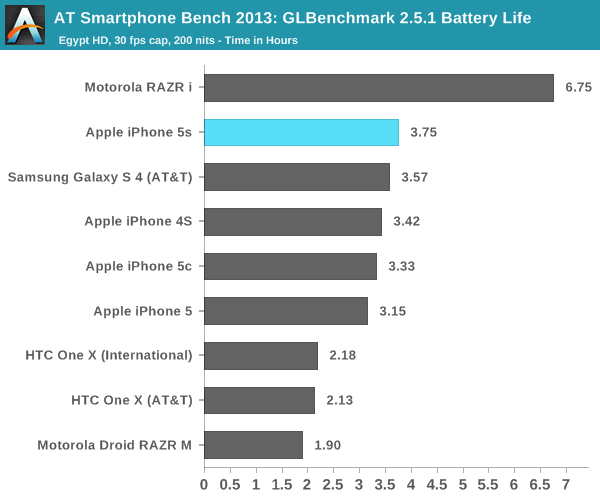The iPhone 5s Review
by Anand Lal Shimpi on September 17, 2013 9:01 PM EST- Posted in
- Smartphones
- Apple
- Mobile
- iPhone
- iPhone 5S
Battery Life
Brian did some excellent sleuthing and came across battery capacities for both the iPhone 5s and 5c in Apple’s FCC disclosures. The iPhone 5 had a 3.8V 5.45Wh battery, while the 5s boosts total capacity to 5.96Wh (an increase of 9.35%). The move to a 28nm process doesn’t come with all of the benefits of a full node shrink, and it’s likely not enough to completely offset the higher potential power draw of a much beefier SoC. Apple claims the same or better battery life on the 5s compared to the iPhone 5, in practice the answer is a bit more complicated.
Unlike previous designs, we’ve never had a half node shrink for an s-SKU. Both the iPhone 3GS and iPhone 4S stayed on the same process node as their predecessor and drove up performance. In the case of the 3GS, the performance gains outweighed their power cost, while in the case of the iPhone 4S we generally saw a regression.
The iPhone 5s improves power consumption by going to 28nm, but turns that savings into increased performance. The SoC also delivers a wider dynamic range of performance than we’ve ever seen from an Apple device. There’s as much CPU power here as the first 11-inch MacBook Air, and more GPU power than an iPad 4.
To find out the balance of power savings vs. additional performance I turned to our current battery life test suite, which we first introduced with the iPhone 5 review last year.
We'll start with our WiFi battery life test. As always, we regularly load web pages at a fixed interval until the battery dies (all displays are calibrated to 200 nits).

The iPhone 5s regresses a bit compared to the 5 in this test (~12% reduction despite the larger battery). We're loading web pages very aggressively here, likely keeping the A7 cores running at their most power hungry state. Even the 5c sees a bit of a regression compared to the 5, which makes me wonder if we're seeing some of the effects of an early iOS 7 release here.
The story on LTE is a bit different. Here we see a slight improvement in battery life compared to the iPhone 5, although the larger battery of the 5s doesn't seem to give it anything other than parity with the 5c:

Our cellular talk time test is almost entirely display and SoC independent, turning it mostly into a battery capacity test:

You can see the close grouping of the smaller iPhones at the bottom of the chart. There's a definite improvement in call time compared to the iPhone 5. We're finally up above iPhone 4S levels there.

Our Egypt HD based 3D battery life test gives us the first indication that Rogue, at least running fairly light code, can be more power efficient than the outgoing 5XT. Obviously the G6430 implemented here can run at fairly high performance levels, so I'm fully expecting peak power consumption to be worse but for more normal workloads there's no regression at all - a very good sign.










464 Comments
View All Comments
solipsism - Wednesday, September 18, 2013 - link
There is definitely additional space required for both 2x images and iPad 1x and 2x images when making an app Universal.akdj - Wednesday, October 9, 2013 - link
I think Apple is NOW mandating retina assets only, isn't that something that came up with the iOS7/XCode 5 updates? (Essentially ensuring an iPad mini 'retina' and the gradual phasing out of the first two iPads....or, is it possible they can 'halve' the resolution just as they do the 2x for iPhone apps on iPads?)tipoo - Tuesday, September 17, 2013 - link
When you say mobile Core 2 class performance, does that mean Core 2 ULVs like in the Macbook Air a few generations back, or Core 2 proper? I can't find any comparisons directly from Bay Trail to Core 2.Krysto - Wednesday, September 18, 2013 - link
Since he said MBA, then ULV.Anand Lal Shimpi - Wednesday, September 18, 2013 - link
Core 2 ULVstipoo - Tuesday, September 17, 2013 - link
Is there supposed to be a 5S in the Basemark X off screen?http://images.anandtech.com/graphs/graph7335/58164...
dylan522p - Tuesday, September 17, 2013 - link
He mentioned he ran into a bug.tipoo - Tuesday, September 17, 2013 - link
is the RAM use of these 64 bit apps higher than the 32 bit ones running on the 5? On x86 at least, moving to 64 bit pointers usually bloats your program about 25%Ryan Smith - Tuesday, September 17, 2013 - link
Yes, RAM usage will be higher to some degree. Apple's own 64-bit guide makes brief mention of it, noting that it needs to be suitably managed to avoid a performance regression.https://developer.apple.com/library/prerelease/ios...
Eug - Wednesday, September 18, 2013 - link
I knew this 5S wasn't "just" another S iteration. I figured this machine was going to be a beast in terms of performance, and the improved camera, as well as the fingerprint scanner make this purchase a no-brainer for me.Except for one thing...
Given the potentially somewhat increased memory usage going to 64-bit, I was disappointed that this machine didn't get 2 GB RAM. 64-bit future-proofs the iPhone 5S such that it is IMHO likely to last one generation longer for iOS updates vs. the iPhone 5/5C. The problem though is by that time (2016?) the 1 GB RAM would likely be pretty limiting.
But then I wonder if even in 2013-2014 it could be somewhat limiting too, even just compared to the 5/5C which would have apps with smaller memory footprints using that same 1 GB amount of RAM.